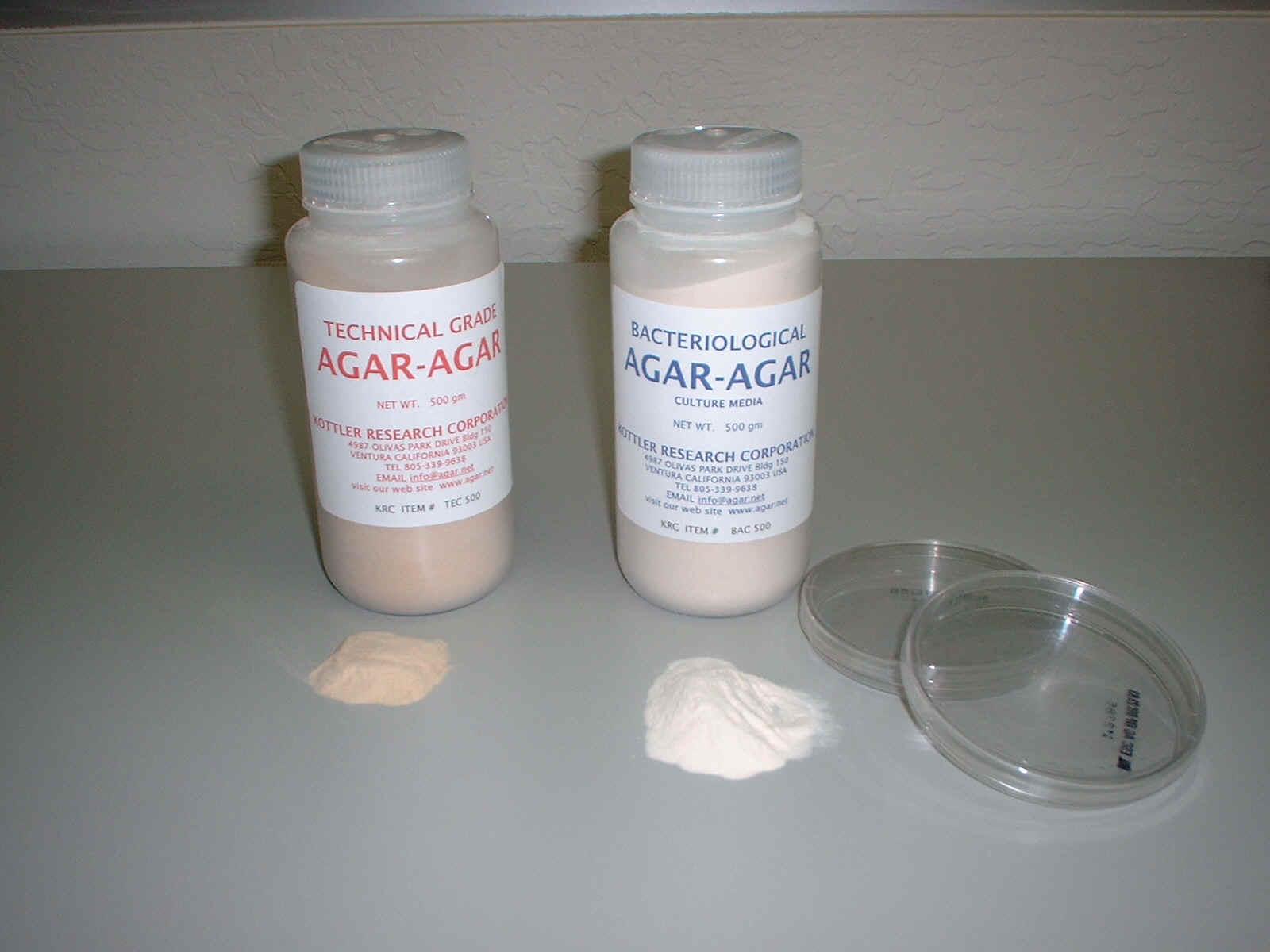Welcome to AGAR.NET
KR Sea Agar Co. (Kottler Research Corp. or KRC) is located in Ventura California. We've been in the agar business since 1975 producing dental and medical products that use agar as a raw material.
Our primary business is not selling agar but we will supply students and labs with a good quality agar at a reasonable price. We only accept on-line orders for the quantities listed below but if you have any technical questions or are looking for larger quantities, please call 805-339-9638 and ask for Dan
Shipments within the U.S.A only
Technical Grade Agar (Food Grade) Powder
Can be used for many microbiology experiments, mycology, etc. (does not contain nutrients, for info see below under "GROWING BACTERIA")
Includes shipping within the USA
Bacteriological Grade Agar Culture Media Powder
(does not contain nutrients, for info see below under "GROWING BACTERIA")
Includes shipping within the USA
KR Sea Agar Co. (part of KRC Corp)
Ventura, California
Please place your order on line via Paypal
Tel 805-339-9638 FAX 805-339-9635
Kottler Research Corp (KRC) website

Our Agar-agar is made from RED ALGAE SEAWEED harvested off the Pacific Coast The species is "Gelidium" that is harvested to a depth of about 40 feet and grows to a length of about 3 feet. Divers harvest the seaweed by hand, cutting with a knife just above the holdfast so the plant will re-grow in about 6 months. The plant is sun dried and bailed waiting for the agar to be extracted. The dried seaweed is rinsed to remove some of the salts and impurities then placed in a large kettle with fresh water. The agar is dissolved in the boiling water. After cooking for almost 24 hours the liquid containing about 2% agar is filtered bleached and purified. . The filtered agar is then cooled. After a gel is formed it's cut into small cubes then dried to contain less then 10% moisture. The dried agar is then ground into a fine powder and packaged.

Information for High School Student Microbiology Projects:
Following is some limited information about how to culture and grow bacteria on agar media This is far from complete. Many microbiology laboratory manuals go into more detail. Ask your science teacher, check with your library, or surf the Internet for detailed information.
Strict safety
precautions should be
followed when growing bacteria, whether a known strain, or unidentified species
from environmental sources. Pure cultures of otherwise " harmless bacteria" can
become contaminated with potential pathogens (disease causing!). Likewise,
bacteria cultured from the skin, mouth, sinks or dirt can be potentially
dangerous if they get into cuts or contact with mucous membranes, including the
eyes, mouth, nose or ears.. Always wear latex gloves and protective clothing
such as a lab coat and safety goggles when handling your cultures, and be
certain to properly dispose of your experiments when finished. We encourage
you to discuss projects involving the growth of bacteria with your science
teacher to make certain appropriate facilities for the growth and handling of
microorganisms are made available to you.
To
grow bacteria you need to supply them with nutrients (a food source). In the
particular case of blood agar the bacteria are getting the majority of their
nutrients from the blood (could be sheep' blood), other nutrients which are
necessary for growth may be added to the agar. The bacteria do not use the
agar for growth, in fact the agar merely provides a semi-solid surface to grow
the bacteria on.
As
for temperature, if you are growing bacteria on blood agar plates it usually
implies that you are trying to culture bacteria which live in an animal.
Therefore you would want to incubate the plates at the same body temperature
of the animal. For example, if you take a sterile
q-tip and swab the inside of your cheek and then use this q-tip to streak a
blood agar plate. Since our body temperature is usually 98.6’F (37 C) you would want to incubate the blood
agar plate at 37 Celsius as the bacteria are accustomed to this
temperature.
Preparation and Application of Agar
Powder
READ ENTIRE INSTRUCTIONS BEFORE
PROCEEDING
To enable microorganisms to grow, a
nutrient must be added, such as carbohydrates and protein derivatives. Many
media formulations have been developed over the years for a variety of
applications. These formulation may consist of specific nutrients or
compounds. For example, nutrient
agar—perhaps the most commonly used general purpose bacteriological
medium—consists of agar (15 grams per liter), beef extract (3 g/L), and peptone
(an enzymatically) digested protein derivative, 5 g/L).
To make one liter of a very simple
and inexpensive culture medium:
1
Add 15 grams of agar to one liter of distilled water.
2
Stir agar powder into the cold water
3
Heat gently, stir constantly until water boils and continue to boil until
the agar is completely dissolved. The resulting solution should be clear,
lightly colored, and with little or no undissolved material.
4
Add 2 bouillon cubes (nutrient)
5
Heat and stir to dissolved agar as described above.
6
Allow to simmer and cool a few minutes before pouring into Petri
dishes
TAKE CARE NOT TO ALLOW
MIXTURE TO OVER BOIL. May cause scalding or burns if splashed on skin. Do not
leave heating container unattended.
Use with adult supervision only.
Pour about 20 ml per petri dish (15 x 100 mm standard), or approximately
8 ml per 15 x 60 mm petri dish. One liter of medium will fill 50 standard Petri
dishes or 125 of the smaller dishes.
This medium will
support adequate growth of many bacterial species. For more culture and
isolation of specific organisms, we strongly recommend the use of an appropriate
nutrient media formulation.
